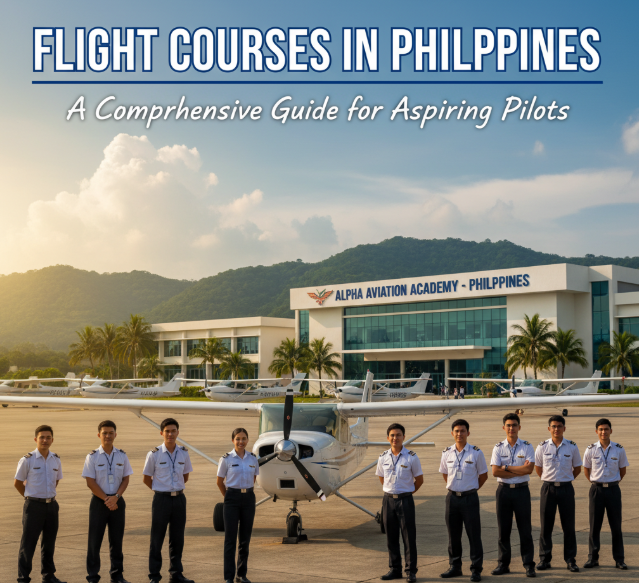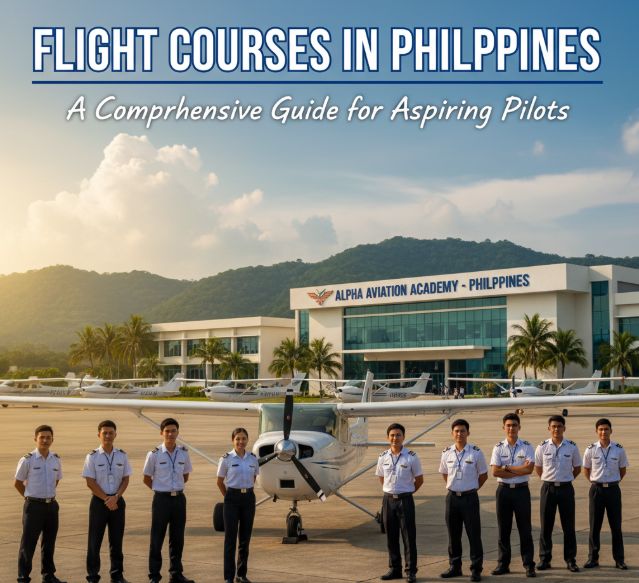
Aviation is an exciting and dynamic field that offers numerous opportunities for individuals with a passion for flight. The Philippines, with its growing aviation industry, offers some of the best flight courses in the world. Whether you’re looking to become an airline pilot, flight instructor, or even embark on a career in space exploration, the Philippines is an excellent place to start your aviation journey. This blog post provides an in-depth look at flight courses in the Philippines, covering essential topics for aspiring pilots.
Introduction to Flight Courses in the Philippines
Flight courses in the Philippines are designed to equip students with the necessary skills and knowledge to pursue a career in aviation. These programs range from private pilot licenses (PPL) to advanced commercial pilot programs. The Philippines has become a popular destination for flight training due to its affordable tuition fees, a wide variety of aviation schools, and its proximity to international aviation routes. The country boasts a number of top-tier aviation academies and flight schools, offering internationally recognized certifications.
Define Flight Courses and Their Relevance
Flight courses are specialized training programs that teach students the theoretical and practical skills required to operate an aircraft. These courses are essential for anyone wishing to become a pilot, whether for commercial, private, or military aviation. In the context of the Philippines, these courses are carefully tailored to meet both national and international standards, making the country an attractive destination for flight training.
Importance of Aviation in the Philippines
Aviation plays a crucial role in the Philippines, both economically and culturally. With over 7,000 islands, the Philippines relies heavily on air travel for connectivity. The aviation sector in the Philippines is growing rapidly, and the demand for skilled pilots is increasing every year.
Economic Impact
Aviation contributes significantly to the country’s economy by facilitating tourism, international trade, and local business connectivity. The Philippines is a hub for various international airlines and has an expanding domestic aviation network. Moreover, the government of the Philippines continues to invest in aviation infrastructure, creating a promising future for aviation professionals.
Connectivity and Tourism
The Philippines is one of the most popular tourist destinations in Southeast Asia, and aviation is key to connecting travelers to the beautiful islands. Whether it’s for local flights or international routes, the demand for qualified pilots in the tourism industry is high.
History and Development of Aviation in the Philippines
The history of aviation in the Philippines dates back to the early 20th century, and it has evolved to become a vital part of the country’s infrastructure.
Early Aviation History of the Country
The first flight in the Philippines took place in 1911, when a Filipino pilot named Jose “Pitong” Cordero made a successful flight in a bamboo-made glider. The development of aviation in the country progressed slowly at first, but by the 1940s, commercial airlines began operating, marking a new era for the Philippines’ aviation industry.
Milestones in Aviation
Key milestones in Philippine aviation include the establishment of flag carriers like Philippine Airlines (PAL) in 1941, which is one of the oldest airlines in Asia. The military’s role in aviation also played a critical part, with the Philippine Air Force providing air defense and transportation services. In recent years, private aviation companies and the government have focused on expanding air travel to support economic growth.
Current Role of Flight Courses in the Philippines
Flight training is a crucial part of the Philippines’ aviation industry. Numerous flight schools and academies have been established across the country to meet the growing demand for skilled pilots. These institutions offer a variety of courses to cater to different aviation needs, from private pilots to commercial pilots and flight instructors.
How These Institutions and Programs Function Today
Today, flight schools in the Philippines offer both ground school and flight training. Ground school covers the theoretical aspects of flying, such as aerodynamics, air navigation, meteorology, aviation regulations, and aircraft systems. Flight training, on the other hand, involves actual flying sessions with certified flight instructors.
Institutes such as the Philippine State College of Aeronautics (PhilSCA) and the Air Link International Aviation College (ALIAC) have produced many of the country’s professional pilots, while private institutions like the CAAP-accredited Cebu Pacific Air Pilot Training Center offer focused programs for commercial pilots.
Their Role in Civil Aviation and Space Exploration
Flight courses not only provide pilots for airlines but also contribute to the country’s civil aviation and defense sectors. Furthermore, as the Philippines explores opportunities in space tourism and satellite technology, aviation training programs are evolving to meet future needs, potentially opening doors for more specialized flight training.
Eligibility, Training, and Skills Required
Basic Qualifications
To enroll in flight courses in the Philippines, certain qualifications must be met:
- Education: A high school diploma is typically required. Some programs may ask for a college degree, especially for more advanced aviation careers.
- Health: A medical certificate is mandatory. The Philippines follows the standards set by the Civil Aviation Authority of the Philippines (CAAP), which may require a Class 1 medical certificate for commercial pilots and a Class 2 for private pilots.
- Age: The minimum age to begin flight training is 17, with no upper age limit for enrollment.
Technical and Soft Skills
Pilot training requires both technical knowledge and soft skills. Some of the essential technical skills include:
- Navigation: Understanding airspace, waypoints, and flight planning.
- Meteorology: Interpreting weather conditions and forecasting for flight safety.
- Aircraft Systems: Knowledge of aircraft components and their functions.
Equally important are soft skills like communication, leadership, problem-solving, and decision-making abilities, as pilots often need to react swiftly to changing conditions in the cockpit.
Institutes, Academies, and Training Centers in the Philippines
The Philippines is home to several world-class aviation institutes and training centers. Here are some prominent ones:
- Philippine State College of Aeronautics (PhilSCA)
- PhilSCA is a government-run institution offering a wide range of aviation courses, from pilot programs to aerospace engineering.
- Air Link International Aviation College (ALIAC)
- A leading private institution known for its comprehensive flight programs.
- Cebu Pacific Air Pilot Training Center
- A specialized center that trains pilots for one of the Philippines’ largest low-cost airlines.
- PAL Aviation School
- Established by Philippine Airlines, it provides specialized training for future pilots of the airline.
- LPU College of Aviation
- Part of the Lyceum of the Philippines University, offering courses for commercial pilot training.
These institutes work closely with the CAAP to ensure their programs meet international standards.
Government Initiatives
The Philippine government has made efforts to improve aviation training through initiatives like the CAAP, which oversees all pilot certifications and training. Furthermore, partnerships with international agencies such as NASA and ISRO help to integrate modern technologies into the training process, preparing students for future aviation challenges.
Technology and Innovation in Aviation Training
Flight training in the Philippines has embraced modern technology, ensuring that students receive the best education possible.
Flight Simulators
Flight simulators are a crucial part of aviation training, offering students the ability to practice emergency scenarios, navigation, and flight maneuvers without leaving the ground. These simulators provide a realistic environment, making the learning experience safer and more effective.
Artificial Intelligence in Space Travel
With the growing interest in space travel, AI technologies are becoming increasingly integrated into flight training. Concepts such as digital cockpits, spacecraft navigation, and autonomous flight systems are being explored, which could significantly impact the future of pilot training.
Challenges Faced in Pilot Training in the Philippines
Despite the growth in aviation, there are several challenges to pilot training in the Philippines.
Infrastructure Gaps
While the country has made great strides, infrastructure gaps remain, particularly in terms of modern airports and aviation technology. These gaps can slow down the development of pilot training programs.
High Costs
Flight training in the Philippines can be expensive, especially for students pursuing commercial pilot training. While it is more affordable than in some other countries, the cost remains a barrier for many aspiring pilots.
Brain Drain
Many Filipino pilots trained in the country often seek employment abroad due to better pay and career opportunities, which can contribute to a shortage of skilled pilots in the local aviation industry.
Future of Flight Courses in the Philippines
The future of flight training in the Philippines looks promising, with emerging opportunities in space tourism and private aviation.
Space Tourism and Private Aviation
The Philippines is positioned to play a role in space tourism, especially with international players like SpaceX and Blue Origin pushing for more accessible commercial space travel. Flight courses are likely to evolve to meet these demands, offering specialized training for space pilots.
National Projects
The country is also engaging in national projects that may inspire future generations of pilots, such as Gaganyaan, India’s human spaceflight mission, and Artemis, the U.S. lunar exploration project.
Career Path & Opportunities
For aspiring pilots, a clear career path exists:
- Education: Start with flight school or an aviation institute.
- Pilot License: Obtain a private pilot license (PPL) and progress to a commercial pilot license (CPL).
- Advanced Training: Engage in further training to become a flight instructor or airline pilot.
- Career: Pursue a career with an airline, in space exploration, or in defense.
Salary Expectations
The salary for pilots in the Philippines varies. A starting commercial pilot can earn around PHP 50,000 to PHP 100,000 per month, while senior pilots may earn upwards of PHP 150,000 per month. However, many Filipino pilots seek higher-paying opportunities abroad.
FAQs
- How much does pilot training cost in the Philippines?
The cost of pilot training in the Philippines can range from PHP 600,000 to PHP 2,000,000, depending on the type of course. - Which is the best aviation institute in the Philippines?
Some of the top institutes include PhilSCA, ALIAC, and Cebu Pacific Air Pilot Training Center. - What qualifications are needed for pilot training in the Philippines?
Applicants need a high school diploma, medical certification, and must meet age requirements. - Is international flight training available in the Philippines?
Yes, many flight schools in the Philippines offer internationally recognized training. - What is the future of aviation in the Philippines?
The future looks bright, with opportunities in space tourism, private aviation, and emerging aviation technologies.
Conclusion
Flight courses in the Philippines offer aspiring pilots a solid foundation for a rewarding career in aviation. With a growing aviation industry, world-class training facilities, and a supportive government, the Philippines remains an attractive destination for flight training. As the industry continues to expand, the future of aviation in the Philippines looks promising, with opportunities for both local and international pilots.
